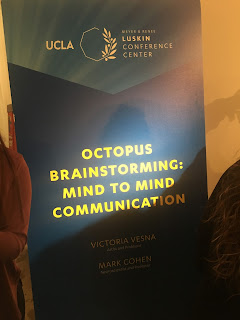Event 3: Live Experiment Explores How Brainwaves React to Music and Color
On May 5th, I attended the Live Experiment that explores how brainwaves react to music and color. At this event, I learned about a series of collaborative works with Professor Victoria Vesna called Brainstorming. At these collaborations, the possibilities of brain to brain communication are explored.
At this event, I learnt how there are signals that can be found on the human head. These signals are commonly known as brainwaves but are actually called EEGs, or “electroencephalogram”. Brain waves were first observed in humans by Hans Berger. He discovered them when learning about the basis of extrasensory perception. Based off this discovery, he believed that these signals could be read like a radio transmission, where people could share their thoughts to one another. Although this seems a far-off reality, his discovery has already shown effects in medicine today with monitoring brain tumors and surgeries.
In this experiment, it incorporates art and science. This experiment reminds me back to my findings in Week 7: Neuroscience and Art. I read an article in the New York Times that approaches art and neuroscience. In this article, Alva Noe, references a neuroscientist at University College of London, Semir Zeki, who comes up with a clever little saying that goes “it is the brain that sees art and it is the brain that makes art,” (Noe 2015). I like this quote as I feel it is represented in experiments like the octopus headband and more. Without our brain, everything we interpret and believe about art would not exist as we would not be able to see or make art.

 |
| Mathematical Analysis |
Further, there is an oval-shaped helmet that resembled an electric octopus. These helmets were created by Vesna and Cohen and are programmed to change colors according to the brainwaves of their respective wearers. They record tiny volts and signal amplitude covariance. One of the main things I learnt about this experiment is how even those that were offstage played a role since the brain activity of everyone in the crowd could affect the subconscious behavior of the participants wearing the helmets and vice versa.
Brainstorming through Empathy uses mathematical analysis to see and find the similarities between brainwaves. Through music and lights, experiences are developed that deepen communication through brain signals. Cohen and Vesna are testing if the sense of togetherness felt between humans can be seen with matching brain waves. It doesn’t necessarily mean the same thoughts or feelings but rather the same brain waves on a subconscious level.
This event inspired my midterm project. I proposed through the manufacture and application of a headband on a robot, a user would not have to physically be somewhere to learn and gain the knowledge presented by being at that specific place. The robot could go in his or her place instead and learn it for this person. The user would then be able to later wear the headband that was on the robot and feel as if he or she was at the lecture/event and would understand all the concepts completely. The objective of this project was to help students fully understand the material and concepts when he or she cannot be there physically. A robot constructed with a removable headband that would transmit all the knowledge the robot has on a certain concept to a human being. Like the octopus headband, my robot headband would send all of the information to the brain through transmitters just like seen in the Live Experiment that Explores How Brainwaves React to Music and Color, an event I recently went to on campus. The robot would be attuned to each person and would transfer the knowledge in a way the human being would be able to understand. Participants would wear the headband and receive knowledge on the ideas and concepts from the class they missed. Thus, they would effectively be able to do their homework.
All in all, many of the associations of artists and neuroscientists have resulted in some of the most dynamic inventions and collaborations. I think it also attests to the universal idea that there is something inside us that makes us think and feel, (Descartes). The fact that we haven’t expanded on the thought of Descartes, that the brain proves consciousness through the immaterial soul, amazes me. That is why this event really excited me. I think this is a step in the right direction as it is fulfilling the opportunity of tackling the unknown and making inquiries! I thoroughly enjoyed this event and I'm glad I attended it.
All in all, many of the associations of artists and neuroscientists have resulted in some of the most dynamic inventions and collaborations. I think it also attests to the universal idea that there is something inside us that makes us think and feel, (Descartes). The fact that we haven’t expanded on the thought of Descartes, that the brain proves consciousness through the immaterial soul, amazes me. That is why this event really excited me. I think this is a step in the right direction as it is fulfilling the opportunity of tackling the unknown and making inquiries! I thoroughly enjoyed this event and I'm glad I attended it.




Comments
Post a Comment